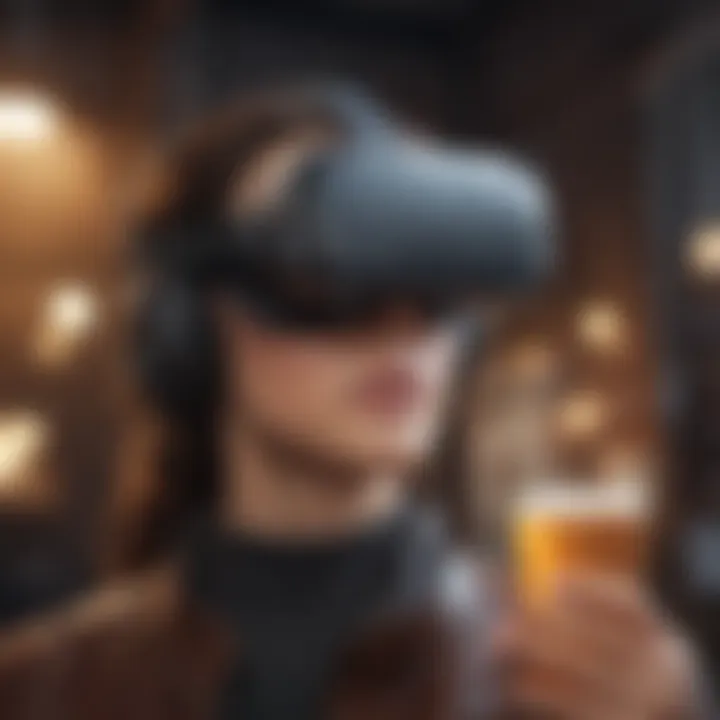Exploring Virtual Reality Games on iPhone


Intro
Virtual reality (VR) on mobile platforms, particularly iPhone, represents a transformative phase not just in gaming but in broader digital interactions. With the enhancement of processing power, graphically demanding applications are now feasible on handheld devices, which was once the domain of high-end consoles and PCs. The convergence of immersive experiences with portable technology is reshaping how players engage with games, making it essential to explore what this means for both casual gamers and serious enthusiasts.
In this article, we delve into various aspects of virtual reality games available on iPhone. From analyzing noteworthy titles and their gameplay mechanics to examining performance metrics and user engagement strategies, our aim is to provide a thorough overview. We will also consider the evolution of mobile VR gaming and its impact on the overall gaming landscape, focusing on how these games can be optimized for an enhanced experience.
Understanding the market trends and identifying compatibility issues is particularly relevant. As VR continues to evolve, so too do the opportunities, challenges, and innovations associated with it. This guide is aimed at gamers of all ages, providing crucial insights into the emerging field of mobile VR gaming.
Prelude to Virtual Reality on iPhone
Virtual reality (VR) gaming has gained significant traction in recent years, particularly on mobile devices like the iPhone. This section aims to articulate the importance of understanding the landscape of VR on iPhones. As technology continues to evolve, the capabilities of the iPhone have expanded, making it a viable platform for immersive gaming experiences.
The potential that VR offers in mobile gaming is multifaceted. First, it provides users with a unique way to interact with games, immersing them fully into the virtual environments. Players are no longer mere observers; they become part of the game world. This enhanced interactivity not only captivates attention but can also lead to greater satisfaction and emotional engagement. Moreover, VR can cater to a wide audience, from casual gamers to seasoned enthusiasts, enriching the community as a whole.
Some considerations are essential when discussing VR for iPhones. The requirements for smooth performance and high-quality graphics can be more demanding compared to traditional gaming. The necessity for compatibility with headsets and other accessories is also a critical issue. The user experience will differ based on hardware models, making it important for players to understand their device's limitations.
In summary, the integration of VR into mobile gaming on the iPhone represents an exciting frontier. By focusing on the dynamics of this technology, we can appreciate how it reshapes gaming experiences, enhances user engagement, and influences market trends.
Defining Virtual Reality in Mobile Gaming
Virtual reality in mobile gaming refers to the use of digital environments that users can access and navigate using their smartphones, specifically enhanced by the capabilities of VR headsets. Unlike traditional gaming, where interaction occurs through standard screens and controllers, VR immerses the player into a three-dimensional space. The goal is to create experiences that are not just played, but felt. This immersive quality sets VR apart as a significant innovation in the gaming landscape.
The key components of VR gaming include tracking systems, headset displays, and interactive gameplay designed to respond to a player’s movements. These features collectively create a sense of presence within the game, allowing players to feel as though they are physically part of the virtual world.
The Rise of iPhones in VR Gaming
The rise of iPhones in the realm of virtual reality gaming can be attributed to several influential factors. First, Apple's continuous innovation in hardware has resulted in powerful devices equipped with advanced processors and high-resolution displays. These upgrades enhance visual quality significantly, which is crucial for an immersive VR experience.
Furthermore, the App Store has played a pivotal role in the popularity of VR games on iPhones. The availability of a wide range of VR titles makes it accessible for gamers of different preferences. Many developers are focusing on creating engaging content tailored specifically for mobile VR, expanding the catalog available on iPhones.
Moreover, the compatibility with various VR headsets, such as the Oculus Quest or the HTC Vive, has opened new avenues for mobile users. This flexibility allows players to experience high-quality VR content without being tethered to console systems or computers. The growing popularity of augmented reality features, seen in games like Pokémon GO, also indicates a positive trend toward VR adoption among iPhone users.
Technological Foundations of VR on iPhone
Understanding the technological foundations of VR gaming on iPhone is essential. These foundations dictate not only what kind of experiences are possible but also how users interact within these virtual environments. Key components include hardware capabilities and software requirements. Together, they determine the quality and performance of VR games.
Hardware Capabilities of iPhones
The hardware in iPhones plays a crucial role in VR gaming performance. Every iPhone model comes equipped with a range of advanced features that enhance the virtual reality experience. This includes powerful processors, like the A-series chips, which handle complex graphics and processing tasks efficiently. High-quality displays, such as Retina screens, provide immersive visuals crucial for VR. Additionally, iPhones are equipped with sensors like accelerometers and gyroscopes, which track device orientation and movement. This ensures a realistic interactive environment where users feel as though they are truly embedded in the game.
Moreover, the introduction of augmented reality features in recent models has further pushed the limits of what developers can do with VR on iPhone. The LiDAR scanner in the iPhone 12 Pro and later models allows for enhanced depth perception, making virtual objects appear more grounded in the real world. This depth capability adds a new layer of immersion that is significant for users.
Software Requirements for VR Gaming
Equally important are the software requirements necessary for optimal VR gaming. iOS needs to support VR applications, which often require specific frameworks like ARKit and SceneKit. These frameworks facilitate the creation of detailed and interactive 3D environments. Developers must also consider compatibility with various VR headsets, such as the Oculus Quest or the Merge VR headset. This means the software has to effectively communicate with both the iPhone and the headset, ensuring smooth performance.
Additionally, the user interface (UI) must be intuitive and responsive. Applications must be built to minimize latency, which can disrupt immersion. Regular updates from Apple enhance software capabilities, enabling developers to leverage new technologies for improved performance.


"A powerful chip and advanced software combine to create an unforgettable VR experience on iPhone."
The realm of virtual reality gaming on iPhone continues to expand, attracting both seasoned gamers and newcomers alike. Notable virtual reality games stand as beacons that highlight the potential of this technology on mobile platforms. These games not only reflect high-quality graphics and immersive gameplay but also push the boundaries of what mobile devices can achieve. By focusing on these key titles, we can grasp essential elements such as user engagement, gameplay mechanics, and the overall evolution of VR gaming within the iPhone ecosystem.
Exploring these games is pivotal for several reasons. Firstly, they represent the cutting-edge of VR development tailored specifically for iPhones. Secondly, they provide insights into user preferences and market trends. Lastly, they serve as a guideline for aspiring developers and enthusiasts who aim to understand the current landscape and future possibilities in VR gaming.
Immersive Experiences: Top Titles
Several titles have gained recognition for their capacity to deliver rich, immersive experiences in virtual reality. Games such as Beat Saber, for example, transform music into an interactive rhythm experience, demanding physical engagement and coordination. Another exemplar is VR Roller Coaster, where players can experience the thrill of a roller coaster ride, all from their devices. These games not only utilize the technology but also maximize the hardware capabilities of iPhones, thus creating an engaging experience that appeals to diverse gaming tastes.
Additionally, Good Pizza, Great Pizza enthralls players with its unique twist on pizza-making in a realistic setting. Players take on the role of a pizza shop owner, receiving orders and customizing pizzas based on customer preferences. Such multifaceted gameplay adds layers to the experience, which appeals to casual gamers and VR enthusiasts.
These titles exemplify how alternate realities can be crafted to enhance user experience. Their development has paved the way for future innovations, ensuring that consumers continue to have access to high-quality and immersive content.
Emerging Gems Worth Exploring
While many gamers gravitate towards well-known titles, emerging games on the iPhone VR landscape deserve attention as well. Titles like Evasion: Gun VR are showcasing improved combat mechanics and storytelling focus, drawing players into finely crafted environments where tactical skills matter.
Another noteworthy mention is Wands, which immerses players in a magical dueling game where they wield spells against opposing magicians. The strategic depth and enchanting visuals make this title captivating. Unlike more mainstream games, Wands focuses on providing a nuanced experience that melds strategy and immersion, appealing to niche audiences.
For those seeking a mix of creativity and exploration, The Night Cafe offers a surreal environment inspired by the works of Vincent van Gogh. Through this experience, users can roam a meticulously designed virtual café that transports them to another era. Despite being lesser-known, The Night Cafe stands out due to its artistic approach and emotive atmosphere.
Each of these emerging titles contributes to the rich tapestry of VR gaming on iPhone. They broaden choices for players while challenging developers to innovate continually. Staying informed about these games can lead to rewarding discoveries that enhance gaming experiences.
User Experience in VR Gaming
User experience in virtual reality gaming is a critical component that can greatly impact the enjoyment and immersion the player feels. The seamless integration of hardware and software undeniably influences how players interact with the game. A positive user experience can lead to greater engagement, longer play sessions, and increased satisfaction with the product overall. Conversely, a poorly designed user experience can lead to frustration and disengagement. Therefore, understanding specific elements that contribute to user experience is essential for developers and players alike.
Interaction Models: Controls and Navigation
Interaction models in VR gaming primarily deal with how players control and navigate in virtual environments. These models can include handheld controllers, motion sensors, and even touch gestures on devices like iPhones. Each method offers different advantages and challenges that affect how intuitive a game feels to the user.
For instance, iPhones often utilize touch controls combined with gyroscopic capabilities to create versatile interactions. Players may tap, swipe, or tilt their device to manipulate game elements. This can create a sense of immediacy and control, allowing for smoother gameplay as long as the inputs are well-designed. However, developers must pay attention to accidental inputs; overly sensitive controls can lead to frustration.
Furthermore, the accessibility of these interaction models remains crucial. Not all players have the same dexterity or ability. Considering various physical capabilities and designing inclusive controls ensures a wider audience can enjoy VR experiences.
Visual Fidelity and Optimization Techniques
Visual fidelity in VR gaming refers to the realism and quality of graphics presented to the user. High visual fidelity can significantly enhance immersion, drawing players deeper into the game world. However, achieving this on a device such as an iPhone poses unique challenges. The balance between graphical quality and performance must be managed effectively to prevent issues such as lag or decreased frame rates.
Optimization techniques can help maintain visual fidelity while ensuring smooth gameplay. These may include techniques like level of detail (LOD), where the game's graphics adjust based on how close or far away an object is to the player. Other methods involve reducing texture sizes or implementing frame rate caps during intense scenes. These optimizations allow for greater stability in performance while still delivering engaging visuals.
"The quality of graphics in VR is not just about realism; it profoundly influences player immersion and satisfaction."
To summarize, user experience in VR gaming encompasses various elements, including interaction models and visual fidelity. By focusing on these areas, developers can create more engaging and immersive experiences for players using iPhones.
Market Analysis of iPhone VR Games
The market analysis of iPhone VR games plays a crucial role in understanding the evolving landscape of mobile virtual reality. With the rapid advancement in technology, this sector is positioned for substantial growth. It is vital to examine sales trends and consumer behavior, as they reveal insights into what users prefer and how they interact with VR content. Furthermore, identifying key players in the competitive landscape gives context to the strategic positioning of various companies involved in VR gaming for the iPhone. Understanding these elements not only helps developers create more appealing games but also allows consumers to make informed choices in their gaming pursuits.


Sales Trends and Consumer Behavior
Sales trends in the iPhone VR market indicate a shift towards more immersive experiences, driven by both casual and serious gamers. Statistics show an increase in revenue from VR games on mobile platforms, particularly on iPhone. A few noteworthy trends include:
- Rising Demand for Quality Content: Gamers are seeking high-quality graphics and engaging narratives. They are willing to invest in premium games that offer enhanced experiences.
- In-App Purchases: Many iPhone VR games capitalize on in-app purchases as a revenue model. This approach can create ongoing engagement, allowing users to customize their experiences without needing to purchase a new game.
- User Community Influence: Communities on platforms like Reddit play a significant role in shaping consumer choices. Discussions around gaming experiences often influence purchasing decisions.
Understanding these trends allows developers to align their offerings with consumer expectations and demands. The way consumers interact with VR and the type of content they favor can guide future developments in this space.
Competitor Landscape: Key Players
The competitive landscape of iPhone VR games is characterized by several key players. Each contributes to the market with unique offerings and innovative approaches. Notable companies include:
- Oculus Studios: Known for highly immersive experiences, Oculus continues to expand its influence into mobile gaming.
- Polyarc: With titles like "Moss", Polyarc demonstrates the creativity and depth possible in VR gaming on mobile platforms.
- Survios: This company leverages its extensive experience in VR to deliver dynamic gameplay experiences on iPhones.
As the market grows, new players may emerge, but these companies set the standard for quality and engagement. Monitoring their movements and offerings can provide insight into broader market trends and consumer preferences. Each key player contributes to shaping the future of VR gaming on iPhones, making it essential to stay informed about their developments.
VR Gaming Community and Engagement
In the realm of virtual reality gaming on iPhone, community engagement plays a crucial role. The social aspects of gaming transcend mere entertainment; they foster connections among players and build vibrant ecosystems that enhance the overall experience. This section delves into the significance of the VR gaming community and the various elements that contribute to its growing landscape.
VR gaming creates unique opportunities for interaction that traditional gaming setups lack. Players no longer just compete against each other; they engage, strategize, and collaborate in immersive environments. This engagement offers several benefits:
- Shared Experiences: Players can explore worlds together, offering a sense of companionship even through digital interfaces.
- Knowledge Transmission: Communities often serve as hubs for sharing tips, tricks, and experiences that contribute to skill development.
- Support Networks: Many find friendship and emotional support through interactions within these communities, enhancing the gaming experience.
The increasing usability of platforms such as Discord, Reddit, and Facebook groups boosts the accessibility of VR gaming communities. These platforms allow gamers to share content, discuss experiences, and find like-minded individuals passionate about the same genres and titles. This sense of belonging is vital for the growth of virtual reality games.
“Communities are not just about connection; they are about understanding and shared enjoyment. The more engaged players are, the better experiences they create together.”
Online Forums and Social Media Impact
Online forums and social media platforms significantly shape the VR gaming community. Players use these digital spaces to engage in discussions, share reviews, and post gameplay videos. Notable websites such as Reddit and dedicated VR gaming forums create informal settings for sharing information and experiences.
Some advantages of active online forums include:
- Instant Feedback: Players can discuss the latest titles and receive immediate reactions,
- News Dissemination: Communities help circulate news about updates, patches, or new game releases,
- User-Generated Content: Many players upload tutorials or gameplay snippets that can aid others in navigating challenges in gameplay.
Social media platforms, especially Facebook and Twitter, also serve as important tools for community engagement. Developers often use these platforms to highlight community creations and foster an inclusive atmosphere.
Events and Tournaments in Mobile VR Gaming
The concept of events and tournaments in mobile VR gaming enhances player engagement through competitive play and showcases the potential of the medium. These events create a sense of anticipation and excitement.
Tournaments often have structured formats that encourage participation. Here are some significant aspects:
- Competitive Spirit: Events provide an opportunity for players to engage against one another, elevating the gaming experience through competition.
- Recognition and Rewards: Competitors often receive recognition, in-game rewards, or prizes, encouraging more players to join.
- Networking Opportunities: These gatherings also promote networking among gamers, developers, and industry experts, which can lead to collaborations and further innovation.
Challenges in Developing VR Games for iPhone
Technical Limitations: Hardware and Software


When it comes to creating virtual reality games, hardware plays a central role. iPhones, while powerful, have certain constraints that developers must consider. The graphical prowess of devices like the iPhone 14 Pro Max is impressive, yet it is designed primarily for mobile applications rather than extensive VR environments. The limited processing power compared to dedicated VR systems may affect performance. This limitation can lead to issues such as lag or decreased visual quality during gameplay, which is detrimental to the immersive experience that VR aims to deliver.
In terms of software, developing for the iOS platform comes with its own set of obstacles. Apple's stringent app review process may affect how quickly innovations can be released in the market. Furthermore, compatibility across various iPhone models demands flexibility from developers. A game designed for the most recent model may not perform optimally on older versions, leading to frustration among users.
Thus, understanding these technical limitations is vital. Performance optimization, including efficient code, graphics settings, and resource management, should be a priority in the development process. Considerations like these are essential for delivering a quality VR experience.
User Adoption and Market Penetration
Another challenge in the realm of VR games for iPhone is user adoption. Despite the growing popularity of virtual reality, many gamers remain unfamiliar with the technology. This unfamiliarity creates a barrier that developers must overcome. Users often hesitate to invest in VR, viewing it as a niche entertainment option rather than a mainstream gaming experience. This perception limits market penetration, making it harder for titles to achieve financial viability.
Marketing strategies must evolve to educate consumers about the benefits of VR experiences on their devices. Developers can benefit from engaging potential players through various platforms until they feel comfortable integrating VR into their gaming habits.
For developers navigating these obstacles, community engagement becomes a key component. Encouraging forums and discussions on platforms like Reddit or Facebook can help demystify VR gaming for iPhone and boost user confidence in trying new titles. Moreover, successful community-driven approaches can provide invaluable feedback that enhances future game iterations.
The Future of VR Gaming on iPhone
The future of virtual reality gaming on iPhone is a topic of significant importance as it delves into the evolution and upcoming advancements in the realm of mobile gaming. As technology progresses, the capabilities of iPhones continue to improve, allowing for a more immersive and engaging VR experience. This section will highlight how innovations and trends can shape the future landscape, impacting both developers and gamers alike.
Innovations on the Horizon
Several innovations are set to transform the VR gaming experience on iPhone. These advancements will likely include improvements in hardware specifications, software optimizations, and user interface enhancements.
- Advanced Processing Power: Apple is known for its focus on high-performance chips like the A-series. Future iPhones may integrate even more powerful processing units, which can handle complex VR environments with seamless graphics.
- Improved AR Integration: The blending of augmented reality and virtual reality is a key focus. Future games may exploit ARKit advancements, allowing users to interact with the real world while still enjoying a VR experience. This could include location-based games that use real-world geolocation data.
- Enhanced Visuals: With upcoming technologies like OLED and mini-LED displays, iPhones can deliver better color accuracy and contrast ratios. This will heighten the visual experience, offering players a more engaging world.
- Reduced Latency: Low latency is crucial for VR. Future updates in wireless technology, such as Wi-Fi 6E, may reduce lag, leading to a more responsive gaming experience.
"The convergence of new hardware capabilities and enhanced network performance will likely lead to a renaissance in mobile VR gaming, benefiting developers and users."
When these innovations come together, the result is a vastly improved gaming experience that draws players deeper into virtual worlds.
Potential Trends to Monitor
In addition to innovations, several trends warrant attention for the future of VR gaming on iPhone. Understanding these trends can help both consumers and developers stay informed about where the industry is headed.
- Cross-Platform Play: As games increasingly support cross-platform capabilities, iPhone users may find themselves able to engage with a broader community on various devices, enriching their overall experience.
- Subscriptions Models: More developers might adopt subscription services for access to a library of VR games. This model may increase the accessibility of quality content without large upfront costs.
- Focus on Social Interactions: Recent trends suggest that players are looking for social engagement in VR. Future games may prioritize multiplayer experiences, creating a community aspect that is essential for retention and enjoyment.
- Sustainability in Gaming: As awareness increases around environmental issues, there may be a push for more sustainable practices in VR game development. This can include energy-efficient coding and server practices.
With these trends in mind, it is clear that the future of VR gaming on iPhone is promising. Both players and developers stand to benefit from these advancements, shaping a landscape that is more immersive, interactive, and community-focused.
Epilogue
In this article, we have delved into the fascinating world of virtual reality games available on iPhones. The growing prevalence of VR technology within mobile gaming highlights numerous vital elements worth considering. An informed understanding of these aspects contributes significantly to both gamers and developers.
Summation of Key Insights
The insights presented throughout this article encompass various dimensions of VR gaming on iPhones. First, we discussed the technological foundations driving these experiences, which provide users with immersive gameplay. The hardware of iPhones, combined with optimized software, creates engaging environments.
In addition, notable games illustrate the expansive range of experiences available. Titles such as "Beat Saber" and "The Walking Dead: Saints & Sinners" showcase how developers are pushing boundaries. Moreover, understanding the user experience plays a crucial role in shaping player interactions. Factors like intuitive controls and visual fidelity significantly enhance engagement.
We also examined the burgeoning market and its potential, evidenced by sales trends and competitor analysis. The rapidly evolving industry indicates that there is much opportunity for both established players and emerging developers.
Final Thoughts on the iPhone VR Gaming Landscape
Looking ahead, the iPhone VR gaming landscape appears bright. As technology improves, virtual reality games will likely become more sophisticated. Innovations such as augmented reality integration and AI-driven narratives could redefine how players interact with virtual environments.
Users should stay informed about upcoming titles and trends to ensure they maximize their gaming experiences. Active participation in online communities can lead to better understanding and appreciation of this genre. Those who embrace VR on iPhones are well-positioned to be part of this evolving movement, enriching their gaming endeavors.
"The future of gaming is not just a change in how we play, but a transformation in our experiences."



